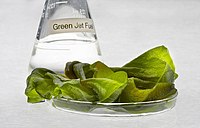
Photo from wikipedia
Botryococcus braunii can produce both long-chain hydrocarbons as well as carbohydrates in large quantities, and is therefore a promising industrial organism for the production of biopolymer building blocks. Many studies… Click to show full abstract
Botryococcus braunii can produce both long-chain hydrocarbons as well as carbohydrates in large quantities, and is therefore a promising industrial organism for the production of biopolymer building blocks. Many studies describe the use of different strains of Botryococcus braunii but differences in handling and cultivation conditions make the comparison between strains difficult. In this study, 16 B. braunii strains obtained from six culture collections were compared for their biomass productivity and hydrocarbon and carbohydrate content. Biomass productivity was highest for AC768 strain with 1.8gL-1day-1, while hydrocarbon production ranged from none to up to 42% per gram biomass dry weight, with Showa showing the highest hydrocarbon content followed by AC761. The total carbohydrate content varied from 20% to 76% per gram of the biomass dry weight, with CCALA777 as the highest producer. Glucose and galactose are the main monosaccharides in most strains and fucose content reached 463mgL-1 in CCALA778.
Journal Title: Journal of biotechnology
Year Published: 2017
Link to full text (if available)
Share on Social Media: Sign Up to like & get
recommendations!